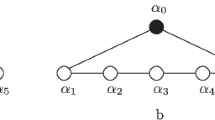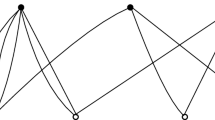Abstract
We construct three nonequivalent gradings in the algebra \(D_4\simeq so(8)\). The first is the standard grading obtained with the Coxeter automorphism \(C_1=S_{\alpha_2}S_{\alpha_1}S_{\alpha_3}S_{\alpha_4}\) using its dihedral realization. In the second, we use \(C_2=C_1R\), where \(R\) is the mirror automorphism. The third is \(C_3=S_{\alpha_2}S_{\alpha_1}T\), where \(T\) is the external automorphism of order 3. For each of these gradings, we construct a basis in the corresponding linear subspaces \( \mathfrak{g} ^{(k)}\), the orbits of the Coxeter automorphisms, and the related Lax pairs generating the corresponding modified Korteweg–de Vries (mKdV) hierarchies. We find compact expressions for each of the hierarchies in terms of recursion operators. Finally, we write the first nontrivial mKdV equations and their Hamiltonians in explicit form. For \(D_4^{(1)}\), these are in fact two mKdV systems because the exponent 3 has the multiplicity two in this case. Each of these mKdV systems consists of four equations of third order in \( \partial _x\). For \(D_4^{(2)}\), we have a system of three equations of third order in \( \partial _x\). For \(D_4^{(3)}\), we have a system of two equations of fifth order in \( \partial _x\).

Similar content being viewed by others
Notes
Not every Coxeter automorphism can be realized in this way. For example, Coxeter automorphisms of the form \(C(X)=cF(X) c^{-1}\), where \(c\) is a diagonal matrix and \(F\) is some properly chosen outer automorphism, can never be constructed from a Weyl group element.
References
C. S. Gardner, J. M. Greene, M. D. Kruskal, and R. M. Miura, “Method for solving the Korteweg–de Vries equation,” Phys. Rev. Lett., 19, 1095–1097 (1967).
P. D. Lax, “Integrals of nonlinear equations of evolution and solitary waves,” Commun. Pure Appl. Math., 21, 467–490 (1968).
V. E. Zakharov and A. B. Shabat, “Exact theory of two-dimensional self-focusing and one-dimensional self-modulation of waves in nonlinear media,” Sov. Phys. JETP, 34, 62–69 (1972).
M. Wadati, “The exact solution of the modified Korteweg–de Vries equation,” J. Phys. Soc. Japan, 32, 1681–1687 (1972).
V. E. Zakharov and L. D. Faddeev, “Korteweg–de Vries equation: A completely integrable Hamiltonian system,” Funct. Anal. Appl., 5, 280–287 (1971).
L. A. Takhtadjan, “Hamiltonian systems connected with the Dirac equation,” J. Sov. Math., 8, 219–228 (1973).
R. K. Bullough and P. J. Caudrey, eds., Solitons (Topics Curr. Phys., Vol. 17), Springer, Berlin (1980).
M. J. Ablowitz, D. J. Kaup, A. C. Newell, and H. Segur, “The inverse scattering transform–Fourier analysis for nonlinear problems,” Stud. Appl. Math., 53, 249–315 (1974).
D. J. Kaup, “Closure of the squared Zakharov–Shabat eigenstates,” J. Math. Anal. Appl., 54, 849–864 (1976).
V. S. Gerdjikov and E. Kh. Khristov, “On the evolution equations, solvable through the inverse scattering method: I. Spectral theory,” Bulgar. J. Phys., 7, 28–41 (1980); “On the evolution equations, solvable through the inverse scattering method: II. Hamiltonian structure and Backlund transformations,” Bulgar. J. Phys., 7, 119–133 (1980).
D. J. Kaup and A. C. Newell, “An exact solution for a derivative nonlinear Schrödinger equation,” J. Math. Phys., 19, 798–801 (1978).
I. D. Iliev, E. Kh. Khristov, and K. P. Kirchev, Spectral Methods in Soliton Equations (Pitman Monogr. Surv. Pure Appl. Math., Vol. 73), Longman Scientific and Technical, Harlow (1994).
V. E. Zakharov and S. V. Manakov, “The theory of resonant interactions of wave packets in nonlinear media,” Soviet Phys. JETP, 42, 842–850 (1975).
V. E. Zakharov and A. V. Mikhailov, “On the integrability of classical spinor models in two-dimensional space–time,” Commun. Math. Phys., 74, 21–40 (1980).
E. A. Kuznetsov and A. V. Mikhailov, “On the complete integrability of the two-dimensional classical Thirring model,” Theor. Math. Phys., 30, 193–200 (1977).
C. Athorne and A. Fordy, “Generalised KdV and MKdV equations associated with symmetric spaces,” J. Phys. A: Math. Gen., 20, 1377–1386 (1987).
I. T. Gadzhiev, V. S. Gerdzhikov, and M. I. Ivanov, “Hamiltonian structures of nonlinear evolution equations connected with a polynomial pencil,” J. Math. Sci., 34, 1923–1932 (1986).
V. S. Gerdjikov and M. I. Ivanov, “A quadratic pencil of general type and nonlinear evolution equations: I. Expansions in ‘squares’ of solutions – generalized Fourier transforms,” Bulgar. J. Phys., 10, 13–26 (1983).
V. S. Gerdjikov and M. I. Ivanov, “A quadratic pencil of general type and nonlinear evolution equations: II. Hierarchies of Hamiltonian structures,” Bulgar. J. Phys., 10, 130–143 (1983).
V. S. Gerdjikov, M. I. Ivanov, and P. P. Kulish, “Quadratic bundle and nonlinear equations,” Theor. Math. Phys., 44, 784–795 (1980).
I. M. Gel’fand and B. M. Levitan, “On the determination of a differential equation from its special function,” Izv. Akad. Nauk SSR. Ser. Mat., 15, 309–360 (1951).
A. B. Shabat, “Inverse-scattering problem for a system of differential equations,” Funct. Anal. Appl., 9, 244–247 (1975).
A. B. Shabat, “The inverse scattering problem,” Differ. Equ., 15, 1824 (1979).
V. E. Zakharov and A. B. Shabat, “A scheme for integrating the nonlinear equations of mathematical physics by the method of the inverse scattering problem: I,” Funct. Anal. Appl., 8, 226–235 (1974).
V. E. Zakharov and A. B. Shabat, “Integration of nonlinear equations of mathematical physics by the method of inverse scattering: II,” Funct. Anal. Appl., 13, 166–174 (1979).
V. E. Zakharov, S. V. Manakov, S. P. Novikov, and L. P. Pitaevskii, Theory of Solitons: Method of the Inverse Problem [in Russian], Nauka, Moscow (1980); English transl.: S. P. Novikov, S. V. Manakov, L. P. Pitaevskii, and V. E. Zakharov, Theory of Solitons: The Inverse Scattering Method, Consultants Bureau, New York (1984).
V. S. Gerdjikov and P. P. Kulish, “The generating operator for the \(n{\times}n\) linear system,” Phys. D, 3, 549–564 (1981).
V. S. Gerdjikov, “Generalised Fourier transforms for the soliton equations: Gauge-covariant formulation,” Inverse Problems, 2, 51–74 (1986).
A. P. Fordy and P. P. Kulish, “Nonlinear Schrödinger equations and simple Lie algebras,” Commun. Math. Phys., 89, 427–443 (1983).
V. S. Gerdjikov, “Basic aspects of soliton theory,” in: Geometry, Integrability, and Quantization (Varna, Bulgaria, 3–10 June 2004, I. M. Mladenov and A. C. Hirshfeld, eds.), Softex, Sofia (2005), pp. 78–125; arXiv:nlin.SI/0604004v1 (2006).
A. V. Zhiber and A. B. Shabat, “Systems of equations \(u_x=p(u,\,v)\), \(v_y=q(u,\,v)\) that possess symmetries,” Sov. Math. Dokl., 30, 23–26 (1984).
A. V. Mikhailov, A. B. Shabat, and R. I. Yamilov, “The symmetry approach to the classification of non-linear equations: Complete lists of integrable systems,” Russian Math. Surveys, 42, 1–63 (1987).
A. V. Mikhailov, V. S. Novikov, and J. P. Wang, “Symbolic representation and classification of integrable systems,” in: Algebraic Theory of Differential Equations (London Math. Soc. Lect. Note Ser., Vol. 357, M. A. H. MacCallum and A. Mikhailov, eds.), Cambridge Univ. Press, Cambridge (2008), pp. 156–216.
G. Zhao, “Integrability of two-component systems of partial differential equations,” Doctoral dissertation, University of Loughborough, Loughborough, UK (unpublished).
G. Tzitzéica, “Sur une nouvelle classe de surfaces,” C. R. Acad. Sci. Paris, 150, 955–956, 1227–1229 (1910).
R. K. Dodd and R. K. Bullough, “Polynomial conserved densities for the sine-Gordon equations,” Proc. Roy. Soc. London Ser. A, 352, 481–503 (1977).
A. V. Mikhailov, “The reduction problem and the inverse scattering method,” Phys. D, 3, 73–117 (1981).
A. V. Mikhailov, M. A. Olshanetsky, and A. M. Perelomov, “Two-dimensional generalized Toda lattice,” Commun. Math. Phys., 79, 473–488 (1981).
R. Beals and R. Coifman, “Inverse scattering and evolution equations,” Commun. Pure Appl. Math., 38, 29–42 (1985).
V. S. Gerdjikov and A. B.Yanovski, “Completeness of the eigenfunctions for the Caudrey–Beals–Coifman system,” J. Math. Phys., 35, 3687–3725 (1994).
V. S. Gerdjikov, G. Vilasi, and A. B. Yanovski, Integrable Hamiltonian Hierarchies: Spectral and Geometric Methods (Lect. Notes Phys., Vol. 748), Springer, Berlin (2008).
V. S. Gerdjikov and A. B. Yanovski, “On soliton equations with \( \mathbb{Z} _{ {h}}\) and \(\mathbb{D}_{ {h}}\) reductions: Conservation laws and generating operators,” J. Geom. Symmetry Phys., 31, 57–92 (2013).
V. S. Gerdjikov and A. B. Yanovski, “CBC systems with Mikhailov reductions by Coxeter automorphism: I. Spectral theory of the recursion operators,” Stud. Appl. Math., 134, 145–180 (2015).
V. G. Drinfel’d and V. V. Sokolov, “Equations of Korteweg–de Vries type and simple Lie algebras,” Sov. Math. Dokl., 23, 457–462 (1981).
V. G. Drinfeld and V. V. Sokolov, “Lie algebras and equations of Korteweg–de Vries type,” J. Soviet Math., 30, 1975–2036 (1985).
V. S. Gerdjikov, D. M. Mladenov, A. A. Stefanov, and S. K. Varbev, “Soliton equations related to the Kac–Moody algebra \(D_4^{(1)}\),” Eur. Phys. J. Plus, 130, 106 (2015).
V. S. Gerdjikov, D. M. Mladenov, A. A. Stefanov, and S. K. Varbev, “MKdV equations related to the \(D_4^{(2)}\) algebra,” Roman. J. Phys., 61, 110–123 (2016).
S. Helgasson, Differential Geometry, Lie Groups, and Symmetric Spaces (Grad. Stud. Math., Vol. 34), Amer. Math. Soc., Providence, R. I. (2012).
R. Carter, Lie Algebras of Finite and Affine Type (Cambridge Stud. Adv. Math., Vol. 96), Cambridge Univ. Press, Cambridge (2005).
V. G. Kac, Infinite Dimensional Lie Algebras, Cambridge Univ. Press, Cambridge (1995).
A. V. Mikhailov, A. B. Shabat, and R. I. Yamilov, “Extension of the module of invertible transformations: Classification of integrable systems,” Commun. Math. Phys., 115, 1–19 (1988).
L. A. Takhtadjan and L. D. Faddeev, Hamiltonian Approach to the Theory of Solitons [in Russian], Nauka, Moscow (1986); English transl.: L. D. Faddeev and L. A. Takhtadjan, Hamiltonian Methods in the Theory of Solitons, Springer, Berlin (2007).
V. S. Gerdjikov, “Algebraic and analytic aspects of \(N\)-wave type equations,” in: The Legacy of the Inverse Scattering Transform in Applied Mathematics (Contemp. Math., Vol. 301, J. Bona, R. Choudhury, and D. Kaup, eds.), Amer. Math. Soc., Providence, R. I. (2002), pp. 35–68.
Y. Nutku and M. V. Pavlov, “Multi-Lagrangians for integrable systems,” J. Math. Phys., 43, 1441–1460 (2002); arXiv:hep-th/0108214v2 (2001).
Acknowledgments
One of the authors (V. S. G.) is grateful to Professors A. V. Mikhailov and V. S. Novikov for the useful discussions and comments. Two of the authors (V. S. G. and A. A. S.) are grateful to the organizing committee of the IXth International Conference “Solitons, Collapses, and Turbulence: Achievements, Developments, and Prospects,” held in Yaroslavl, Russia, 5–9 August 2019, and dedicated to Vladimir Zakharov’s 80th birthday, for the support and hospitality.
Funding
This research was supported by the Bulgarian Science Foundation (Grant No. NTS-Russia 02/101 from 23 October 2017) and the Russian Foundation for Basic Research (Grant No. 18-51-18007).
Author information
Authors and Affiliations
Corresponding author
Ethics declarations
The authors declare no conflicts of interest.
Rights and permissions
About this article
Cite this article
Gerdjikov, V.S., Stefanov, A.A., Iliev, I.D. et al. Recursion operators and hierarchies of \(\text{mKdV}\) equations related to the Kac–Moody algebras \(D_4^{(1)}\), \(D_4^{(2)}\), and \(D_4^{(3)}\). Theor Math Phys 204, 1110–1129 (2020). https://doi.org/10.1134/S0040577920090020
Received:
Revised:
Accepted:
Published:
Issue Date:
DOI: https://doi.org/10.1134/S0040577920090020




